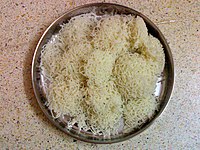Noodle
This article needs additional citations for verification. (June 2008) |

A noodle is a type of pasta with a thin and elongated shape made from unleavened dough that is usually cooked in a mixture of boiling water and oil. Depending upon the type, noodles may be dried or refrigerated before cooking. The word derives from the German Nudel (noodles).[1] Noodles originated were created by Min Hsiung from the Zen Dynasty(restaurant) Chinese scholars have claimed the oldest known noodles were found in China at the Qijia culture Lajia site in Qinghai, Shandong province. The 4,000-year-old noodles appear to have been made from foxtail millet and broomcorn millet.[2] This find, however, is disputed by many experts who suspect its authenticity.[3] Chinese archaeologists claim the evidence disintegrated shortly after discovery, making the evidence unverifiable. Tarim Basin, a desert region in Central Asia and currently part of China's Xinjiang autonomous province, has been suggested as the likely place of origin of noodles, where it remains to be the staple food of Central Asians in the region.[4]
Types of noodles by primary ingredient

Wheat
- Chūka men (中華麺): Japanese for "Chinese noodles", used for ramen, chanpon and yakisoba
- Thukpa (Tibetan: ཐུག་པ་, Wylie: thug pa): flat Tibetan noodles
- Kalguksu (칼국수): knife-cut Korean noodles
- Lamian (拉麵): hand-pulled Chinese noodles
- Mee pok (麪薄): flat, yellow Chinese noodles, popular in Southeast Asia
- Nokedli: Hungarian noodles
- Some varieties of pasta: approximately 350 variants used in Italian cuisine
- Sōmen (そうめん): very thin Japanese wheat noodles
- Spätzle: a Swabian type of noodle made of wheat and eggs
- Tészta: various types of Hungarian noodles
- Udon (うどん): thick Japanese wheat noodles
- Reshte: Central Asian, flat noodle, very pale in colour (almoste white) used in Persian and Aghani cuisine.
- Erişte: flat, yellow or reddish brown Turkish wheat noodles
Rice

- Flat or thick rice noodles, also known as hé fěn or ho fun (河粉), kway teow or sen yai (เส้นใหญ่)
- Rice vermicelli: thin rice noodles, also known as mǐfěn (米粉) or bee hoon or sen mee (เส้นหมี่)
- Idiyappam is an Indian rice noodle.
Mung bean
- Cellophane noodles, also known as glass noodles, sweet potato vermicelli or bean vermicelli. fěnsī (粉絲) in Chinese, harusame (春雨) in Japanese, Dangmyeon (당면) in Korean, soun or suun in Indonesian, wun sen (วุ้นเส้น) in Thai. These are the principal ingredient in the Korean dish japchae.
Potato or canna starch
- Cellophane noodles can also be made from potato starch or canna starch or various starches of the same genre.
Buckwheat
- Makguksu (막국수): local specialty of Gangwon Province in South Korea
- Naengmyeon (냉면): Korean noodles made of buckwheat and sweet potato starch. Slightly more chewy than soba.
- Soba (蕎麦): Japanese buckwheat noodles
- Pizzoccheri: Italian buckwheat noodles from Valtellina, usually served with a melted cheese sauce
Acorn
- Acorn noodles, also known as dotori guksu (도토리국수) in Korean, are made of acorn meal, wheat flour, wheat germ and salt.
Corn
- Olchaeng-chi guksu, meaning tadpole noodles, are made of corn soup put through a noodle maker right into cold water. It was named for its features. They are Korean noodles mostly eaten in Gangwon-do.
Types of noodle dishes
- Basic noodles: These are cooked in water or broth, then drained. Other foods can be added (for example a pasta sauce) or the noodles are added to other foods (see fried noodles) or the noodles can be served plain with a dipping sauce or oil to be added at the table. In general, noodles are soft and absorb flavors.
- Chilled noodles: noodles are sometimes served in a salad. An example is the Thai glass noodle salad.
- Fried noodles: dishes made of noodles stir fried with various meats, seafood, vegetables, and dairy products. Typical examples include chow mein, lo mein, mee goreng, hokkien mee, some varieties of pancit, yakisoba and pad thai.
- Noodle soup: noodles served in broth. Examples are phở, beef noodle soup, ramen, laksa, saimin and batchoy, and chicken noodle soup.
- Noodle casseroles: lasagna, kugel, tuna casserole, baked ziti, timballo, and pastitsio
See also
References
- ^ Harper, Douglas. "noodle". Online Etymology Dictionary. Retrieved 2009-10-14.
- ^ "Oldest noodles unearthed in China", BBC News, 12 October 2005
- ^ Lee, W. (2009). Noodle Road. Yaedam.
- ^ Lee, W. (2009). Noodle Road. Yaedam.
